The newly confirmed Minister of Culture of the Republic of Lithuania, Mindaugas Kvietkauskas, visited Chicago, on September 14. He attended Chicago’s Lithuanian cultural centers – Balzekas Museum of Lithuanian Culture, Lithuanian Research Center, World Lithuanian Center, and spent an afternoon at the editorial offices of Draugas.
Mindaugas Kvietkauskas holds a Ph.D. in Humanities from Vilnius University. He has interned at various academic institutions, such as the Jagiellonian University in Krakow, Poland, New York YIVO Institute, and Yale University. He has served as director and researcher at the Institute of Lithuanian Literature and Folklore in Vilnius and was Review Editor for the cultural journal “Metai.” Mindaugas Kvietkauskas also completed Jewish Studies at the Oriental Institute of the University of Oxford and is one of few Lithuanian scholars who has learned Yiddish, the historic language of Lithuania’s Jewish population.
Draugas editors Ramunė Lapas and Virginija Petrauskienė engaged Mindaugas Kvietkauskas in conversation. They addressed issues relating to cultural cooperation between Lithuania and the US.
We all would agree that Lithuanian culture needs to be more visible in the outside world. Is the presentation of Lithuanian culture on the international front one of the priorities of your ministry?
Recently, Lithuania has intensified its efforts to find outlets for its culture abroad. We have established a Lithuanian cultural attaché network, funded by the Lithuanian Council for Culture (LCC), whose goal is to broadcast works of Lithuanian artists and spearhead international projects on the world stage. Lithuanian organizations and institutions operating overseas can apply to the LCC (www.ltkt.lt/en) for financial support.
This program is already producing tangible results. For instance, Lithuania won the Golden Lion in Italy at the Venice Biennale. (An interview with one of the artists, Lina Lapelytė, who created the award-winning opera “Sun and Sea (Marina),” was published in the June 2019 issue of Draugas News). Here young artists carried out their project with the support of the state. That is where cultural diplomacy is at its best. When such a win is attained, the name of Lithuania echoes throughout the international community.
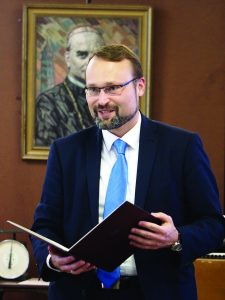
This year was particularly successful. The Lithuanian soprano Asmik Grigorian was recognized in London at the International Opera Awards as the best female soloist in the world. New York-based composer Žibuoklė Martinaitytė won the Gold Medal for her album “In Search of Lost Beauty” at Global Music Awards, and, most recently, filmmaker Audrius Stonys’s film “Bridges of Time” won the Golden Goblet at the Shanghai International Film Festival for best documentary.
As far as international cultural policy is concerned, I am interested in consolidating and strengthening the activities of the Lithuanian Culture Institute (https://english.lithuanianculture.lt) to coordinate our culture programs abroad and support our cultural attachés in performing their mission. Compared to larger, wealthier nations that have been doing this for many years, we have much to learn. A particular disadvantage we see is that we do not have functioning cultural institutes internationally. For example, Germany has the Goethe Institute, Poland has the Polish Cultural Institute, Spain has the Cervantes Institute. Of course, this requires a significant financial commitment. Nevertheless, I believe that we should strive for the creation of such cultural centers throughout the world. Let us hope that this vision can, in time, be realized.
The purpose of my current visit to the US was to attend the first Litvak Days in New York and Chicago, organized in conjunction with the YIVO Institute. It is an excellent opportunity to present Lithuanian culture and Lithuanian Jewish heritage. Besides, there were several important meetings with cultural institutions on various art projects, including a meeting at the Art Institute of Chicago, where we talked about the possible exhibition of Marc Chagall’s painting “White Crucifixion” in Lithuania.
Another goal is to meet with the Lithuanian community and visit Lithuanian cultural institutions. It helps me, as a minister, to understand the specifics of Lithuanian activity in America – to understand the needs and problems and to offer possible solutions.
Former Lithuanian Consul General in Chicago, Marijus Gudynas, has noted that there are many Litvaks here in Chicago, as in all of America, and there is a potential for a fruitful partnership that is currently unutilized. Could you envision any prospects for cooperation at the organizational level, including developing financial support for such a project?
Those relationships are quite extensive in some cases. For example, the New York YIVO Institute for Jewish Research is working very closely with the National M. Mažvydas Library in Vilnius. This includes funding the digitization of the Judaic legacy, both in Lithuania and New York. This is a major ongoing project. They also contribute to education in Lithuania. The World Jewish Congress and the American Jewish Congress not only cooperate with the Lithuanian Jewish community but also with the Government of the Republic of Lithuania and ministries at multiple levels. One of the most successful projects was the return of Samuel Bak’s paintings to Lithuania. The collection is exhibited at the Samuel Bak Museum, a new branch of the Vilna Gaon State Jewish Museum in Vilnius.
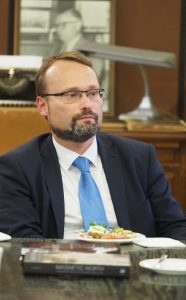
As a researcher myself, I have frequently visited New York and even had an internship at the YIVO Institute. We do joint research and develop publishing projects. An increasing number of Lithuanian scholars are studying Yiddish and Hebrew. A school of Judaic research is being established in Lithuania, including Holocaust studies and cultural subjects as well. Many Litvaks have contributed to the creation of the Lithuanian state, as volunteers and entrepreneurs. Many prominent doctors and jurists aided in the creation of an independent Lithuania. This needs to be acknowledged and appreciated.
I am currently writing a book which is to be published later this year. It presents the poetry and diaries of the poet Matilda Olkinaitė. She was born in Panemunėlis in the Rokiškis region. Her family maintained close contact with the local intelligentsia, including Father Juozapas Matelionis. Olkinaitė wrote in a very literate Lithuanian style. After graduating from Juozas Tumas-Vaižgantas Gymnasium in Rokiškis, she studied French language and literature at Kaunas Vytautas Magnus University and later at Vilnius University. Her entire family was murdered in July 1941, at the very beginning of the Holocaust. The diary and poems of Olkinaitė were preserved by Father Matelionis, who hid them under the altar of his church. The works of Olkinaitė, hidden thus, survived the Soviet occupation. The Lithuanian edition is now being prepared by Prof. Irena Veisaitė and Laima Vincė (Laima Sruoginytė), an American Lithuanian poet. Olnikaitė’s works and diary have been translated into English. Next year we plan to launch this work in America.
The poetry of M. Olkinaitė was highly patriotic. She wrote beautifully about her country; she wrote poems about the Lithuanian hero pilots Darius and Girėnas, and J. Tumas-Vaižgantas; there is also a poem about the President of Lithuania Antanas Smetona. When you read them, you begin to realize what the Holocaust tragedy interrupted.
How did you become interested in the study of Yiddish?
There was no rational reason. I first became intrigued with the language as a teenager when I read Avrom Suckever’s poetry translated into Lithuanian by the poet Alfonsas Bukontas. They were love poems written by Suckever to his wife in the Vilna Ghetto. They both survived the Holocaust.
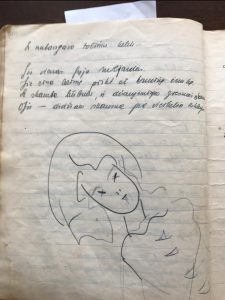
Those poems affected me deeply, and then I thought I would like to learn Yiddish. I have translated Suckever’s collection of poetic prose, The Green Aquarium. It is a very emotional book and literature at its best.
Another reason was that I was keenly interested in the history of Vilnius. As a youth, I was a free spirit and used to wander through the Vilnius Old Town, exploring its courtyards and aged buildings. I admired the letters of Yiddish inscriptions – they were somehow magical, mysterious. I thought: I would like to learn how to read them. It’s hard to explain my fascination. I took Introductory Yiddish at The University of Vilnius. I then realized that there were treasures not known throughout Lithuania and thus often unknown in the world as well. Many Jewish authors lived in the shadows, along with their readers. Most of them perished. Those who survived did not have an easy time getting established in America or Israel. But they produced great literature, and it now helps us discover our natural connection to Lithuania’s Jewish community. These writings can help us scale that painful wall created by the Holocaust. When we reflect upon human experience through literature, through creative works, we can reduce the painful gap created by the Holocaust, which often sets us apart.
The Lithuanian parliament declared 2020 to be the Year of Vilnius Gaon and Lithuanian Jewish History. Are you planning any joint projects with Litvaks living in the US to mark that year?
The Litvak commemorations will take place next year. The 300th anniversary of the Gaon in Vilnius will be commemorated at the YIVO Institute, which preserves Gaon’s significant legacy, specifically the Pinkas register. We are arranging for the display of this important document in Lithuania. Indeed, there is an excellent opportunity for cooperation with Jewish institutions in this undertaking.
As for the presentation of our art and our collaboration with the Litvaks, a retrospective exhibition of the work of poet and filmmaker John Mekas (1922-2019) at the Jewish Museum in New York is planned. This museum is noted for promoting experimental art. Mekas also worked there, curating a film art program, and now the museum plans to host the first major retrospective exhibition after his death. The show will take place in collaboration between the Jewish Museum of New York and the National Gallery of Art in Vilnius. At the same time, exhibitions will be held in New York and Lithuania. An exhibition catalog is also planned and will be published by Yale University Press.
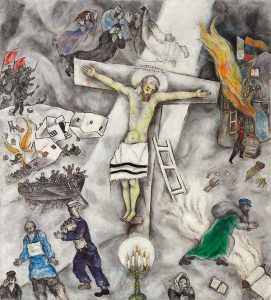
Such cultural events are a great opportunity to rejoice in our homeland and its artists, for art is the nation’s greatest ambassador. Can we expect Lithuanian art and artists to find it easier to cross the ocean?
At the meetings, we talked about the need for us to coordinate our activities and their funding more closely. When important activities take place at the highest level in preparation for state anniversaries, I believe there could be more coordination between the Lithuanian Foundation in the US and the LCC. Daina Urbanavičienė, Chairwoman of the LCC, is planning a visit to the US in 2020. She will visit the Lithuanian Foundation in Chicago and hopefully have a clearer understanding of needs and the coordination of our cultural activities.
There are two different views among immigrants about the preservation of the Lithuanian heritage. Some are convinced that what has been created in the US must remain here. Others are in favor of passing on cultural heritage to Lithuania. What are your thoughts on this topic?
It is difficult to say. Both the Lithuanian Research Center and the Balzekas Museum of Lithuanian Culture in Chicago are valuable institutions, and the existence of these centers is of vital importance here. Institutions created in the diaspora are the backbone of community activities.
Furthermore, Lithuania is becoming global. One can imagine that a person spends a part of his life in Lithuania and another part abroad. Especially young professionals move freely from one country to another. So, it is more difficult to argue one way or the other, should archives remain or be transferred to Lithuania.
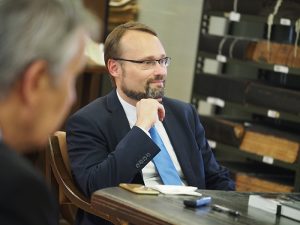
Lithuania has received priceless gifts from the diaspora, important archives that are needed for research institutions and museums operating in Lithuania. Many valuable archives have been transported to Kaunas, particularly to the Maironis Lithuanian Literature Museum and Vytautas Magnus University’s Lithuanian Emigration Institute, where they are researched, catalogued, and exhibited. In this way what was created here becomes an integral part of the literary life and scholarship in Lithuania.
When there are no other prospects, we must arrange for the return of the most valuable archives to Lithuania. Consider, for example, the Jonas Balys archives. [Jonas Balys (1901-2011), a noted ethnologist, served as director of the Lithuanian Folklore Archives from 1935 until 1944. For 25 years, starting in 1956, he worked at the Library of Congress in Washington, DC. His extensive archives have long been housed at the American Lithuanian Cultural Archives in Putnam, Connecticut.] The Jonas Balys archives were transferred to Lithuania. Now, the Institute of Lithuanian Literature and Folklore has an exhibit of his study – his desk, belongings, and books. It also safeguards his archives.
At the same time, I think that the centers that were established here are also important for Lithuanian researchers. They need to have the opportunity to see the locale where Lithuanian culture was locally created.
 DRAUGAS NEWS Lithuanian World Wide News in English
DRAUGAS NEWS Lithuanian World Wide News in English
